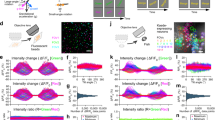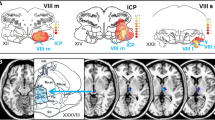Abstract
In decerebrate cats that had been acutely hemilabyrinthectomized (HL), the extracellular activities of vestibular nuclear neurons on the lesioned and labyrinth-intact sides were studied during constant-velocity off-vertical axis rotations (OVAR) in the clockwise (CW) and counterclockwise (CCW) directions (at 10° tilt). Over the range of 1.75–15°/s, two types of neuronal responses were identified on both sides. Some neurons showed symmetric and velocity-stable bidirectional response sensitivity (δ defined as the CW gain over the CCW gain) while other neurons exhibited asymmetric and velocity-variable δ. The mathematically derived gain tuning ratios of these two groups of neurons were within the range of one-dimensional and two-dimensional neurons respectively. The best response orientations in one-dimensional neurons and the orientations of the maximum response vector, S max, in two-dimensional neurons were found to point in all directions on the horizontal plane. On the labyrinth-intact side, both the one-dimensional and two-dimensional neurons showed asymmetry in the neuron numbers and/or the response gains between the two roll quadrants as well as between the two pitch quadrants. In addition, both the neuron number and gain were significantly higher for neurons in the head-down/ipsilateral-side-down half-circle than those in the head-up/contralateral-side-down half-circle. None of the aforementioned asymmetries was observed on the lesioned side. That a comparable pattern of distribution was observed in the one-dimensional and two-dimensional neurons suggests that these neurons maintain a common spatial reference frame in encoding head orientational signals arising from the ipsilateral and contralateral otoliths. Furthermore, a predominance of two-dimensional neurons that exhibited a greater gain with CW rotations was observed on both sides of HL cats. Of the response dynamics observed amongst neurons on the two sides of HL cats, no difference was found with regard to the response gain and the pattern of response lead. However, a difference in response lag was observed between neurons on the two sides of HL cats. These suggest that there is a segregation of otolithic signals to reach the ipsilateral and contralateral vestibular nuclei. Taken together, the present study demonstrates that one-dimensional and two-dimensional neuronal responses could be elicited with inputs arising solely from the ipsilateral or contralateral otoliths. The observed orientational tuning and the CW-CCW asymmetry to bidirectional rotation may provide the essential directional coding of head orientations. Further, the imbalance of spatial/dynamic response patterns between the bilateral vestibular nuclei following the restriction of otolith inputs by HL implies that converging otolithic inputs from the bilateral labyrinths are essential for producing the neuronal responses in control animals. The results are also discussed in terms of the possible contribution of the various neural asymmetries between neuronal subpopulations in the bilateral vestibular nuclei to the behavioral symptoms accompanying acute HL.
Similar content being viewed by others
Author information
Authors and Affiliations
Additional information
Received: 1 March 1996 / Accepted: 20 September 1996
Rights and permissions
About this article
Cite this article
Chan, Y. The coding of head orientations in neurons of bilateral vestibular nuclei of cats after unilateral labyrinthectomy: response to off-vertical axis rotation. Exp Brain Res 114, 293–303 (1997). https://doi.org/10.1007/PL00005638
Issue Date:
DOI: https://doi.org/10.1007/PL00005638




